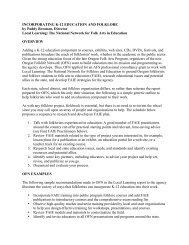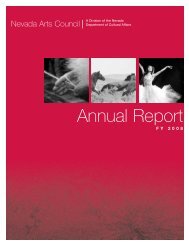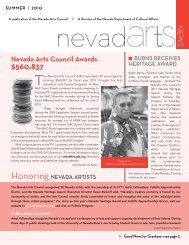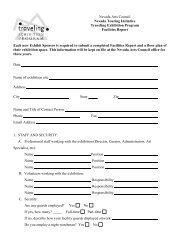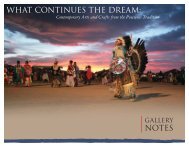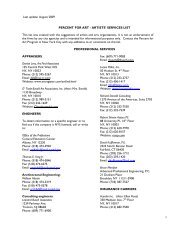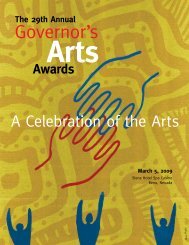Handed Down - Nevada Arts Council
Handed Down - Nevada Arts Council
Handed Down - Nevada Arts Council
Create successful ePaper yourself
Turn your PDF publications into a flip-book with our unique Google optimized e-Paper software.
1989–1990<br />
Saddlemaking:<br />
Spider Teller and Ira Walker<br />
Northern <strong>Nevada</strong> has a large contingent of Indian<br />
buckaroos, and at least one Indian saddle maker.<br />
Spider Teller has a saddle shop in Owyhee, on the<br />
Duck Valley Shoshone-Paiute Reservation, and crafts<br />
custom gear for working cowboys in the area. Now<br />
in his mid-40’s, Spider was raised in Owyhee and has<br />
worked on ranches around Tonopah and in Idaho.<br />
He studied saddle making in 1971 and has been at it<br />
ever since. Spider is fascinated by concepts of design in<br />
stamping leather for saddles, and draws all his designs<br />
freehand on the damp leather. “You know just about<br />
where everything’s going to go, you already got it in<br />
your mind, you know, where your flowers are going<br />
to go, how your stems are going to go,” he says. He<br />
begins by drawing in the main elements—the large<br />
flowers and stems—with a swivel knife, then filling in<br />
with buds, scrolls and leaves and adding details with<br />
other stamping tools. Spider is critical of saddle designs<br />
that “just go out to nowhere” and works hard to tie all<br />
elements of his designs together.<br />
Ira Walker was raised in Owyhee and has been<br />
“hanging around” Spider’s shop since it opened, picking<br />
up quite a bit of leatherworking skill. He has made<br />
one saddle, and says a lot of his knowledge is coming<br />
back as he works closely with Spider. He was raised<br />
in the ranching life, and currently makes his living as<br />
a roper on the rodeo circuit. Spider says Ira is “pretty<br />
much along” in saddle making, and after helping him<br />
with one saddle will make one on his own. Naturally,<br />
Spider spent a lot of time teaching<br />
him to use a swivel knife and perfecting<br />
his stamping and designing.<br />
According to Spider, “Like<br />
on your stamping tools, lot of guys<br />
think it’s easy. You’ve got to hold<br />
it tight in your hand, otherwise<br />
it’ll get to jumping on you. If you<br />
don’t hit it hard, you’re not going<br />
to get a dark…you’re not going to<br />
get that color to it.” He dampens<br />
the leather and wraps it in plastic for a few days to get<br />
it really wet for the initial designing, but then lets it get<br />
almost dry before stamping the details in order to get a<br />
good dark color.<br />
There are a lot of details to look for in a saddle—<br />
quality of the leather, construction details, fit and comfort—but<br />
Spider admits that he is always trying to improve<br />
his work. “There’s always a mistake on a saddle,<br />
always, you always make a mistake on a saddle, it just<br />
can’t be perfect,” he says. But as long as there are cowboys,<br />
saddle makers will keep trying to get it right.<br />
Spider Teller<br />
with one of his<br />
saddles.<br />
Spider Teller and Ira Walker<br />
working in Spider’s shop<br />
in Owyhee.<br />
13




